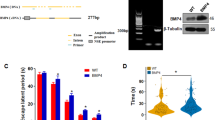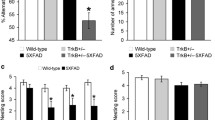Abstract
Alzheimer’s disease (AD) can incur significant health care costs to the patient, their families, and society; furthermore, effective treatments are limited, as the mechanisms of AD are not fully understood. This study utilized twelve adult male tree shrews (TS), which were randomly divided into PBS and amyloidbetapeptide1-40 (Aβ1-40) groups. AD model was established via an intracerebroventricular (icv) injection of Aβ1-40 after being incubated for 4 days at 37 °C. Behavioral, pathophysiological and molecular changes were evaluated by hippocampal-dependent tasks, magnetic resonance imaging (MRI), silver staining, hematoxylin–eosin (HE) staining, TUNEL assay and gene sequencing, respectively. At 4 weeks post-injection, as compared with the PBS group, in Aβ1-40 injected animals: cognitive impairments happened, and the hippocampus had atrophied indicated by MRI findings; meanwhile, HE staining showed the cells of the CA3 and DG were significantly thinner and smaller. The average number of cells in the DG, but not the CA3, was also significantly reduced; furthermore, silver staining revealed neurotic plaques and neurofibrillary tangles (NFTs) in the hippocampi; TUNEL assay showed many cells exhibited apoptosis, which was associated with downregulated BCL-2/BCL-XL-associated death promoter (Bad), inhibitor of apoptosis protein (IAP), Cytochrome c (CytC) and upregulated tumor necrosis factor receptor 1 (TNF-R1); lastly, gene sequencing reported a total of 924 mobilized genes, among which 13 of the downregulated and 19 of the upregulated genes were common to the AD pathway. The present study not only established AD models in TS, but also reported on the underlying mechanism involved in neuronal apoptosis associated with multiple gene expression.














Similar content being viewed by others
References
Mayeux R, Stern Y (2012) Epidemiology of Alzheimer disease. Cold Spring Harb Perspect Med 2(8):a006239. doi:10.1101/cshperspect.a006239
Weiner MW, Veitch DP, Aisen PS, Beckett LA, Cairns NJ, Green RC, Harvey D, Jack CR, Jagust W, Liu E, Morris JC, Petersen RC, Saykin AJ, Schmidt ME, Shaw L, Shen L, Siuciak JA, Soares H, Toga AW, Trojanowski JQ (2013) The Alzheimer’s disease neuroimaging initiative: a review of papers published since its inception. Alzheimers Dement 9(5):e111–e194
James ML, Belichenko NP, Nguyen TV, Andrews LE, Ding Z, Liu H, Bodapati D, Arksey N, Shen B, Cheng Z, Wyss-Coray T, Gambhir SS, Longo FM, Chin FT (2015) PET imaging of translocator protein (18 kDa) in a mouse model of Alzheimer’s disease using N-(2,5-dimethoxybenzyl)-2-18F-fluoro-N-(2-phenoxyphenyl)acetamide. J Nucl Med 56(2):311–316. doi:10.2967/jnumed.114.141648
Kolobov VV, Davydova TV, Fomina VG (2014) Protective action of glutamate antibodies on increased expression of genes of programmed death of rat brain cells induced by injection of a beta-amyloid fragment (25–35). Izv Akad Nauk Ser Biol 2:133–141
Benhaberou-Brun D (2015) Alzheimer disease. A protective gene. Perspect Infirm 12(1):58–59
Hogan DB (2014) Long-term efficacy and toxicity of cholinesterase inhibitors in the treatment of Alzheimer disease. Can J Psychiatry 59(12):618–623
Pawlik M, Fuchs E, Walker LC, Levy E (1999) Primate-like amyloid-beta sequence but no cerebral amyloidosis in aged tree shrews. Neurobiol Aging 20(1):47–51
Yamashita A, Fuchs E, Taira M, Hayashi M (2010) Amyloid beta (Abeta) protein- and amyloid precursor protein (APP)-immunoreactive structures in the brains of aged tree shrews. Curr Aging Sci 3(3):230–238
Adlard PA, Tran BA, Finkelstein DI, Desmond PM, Johnston LA, Bush AI, Egan GF (2014) A review of beta-amyloid neuroimaging in Alzheimer’s disease. Front Neurosci 8:327
Tan CH, Wei W, Johnson V, Kundra V (2012) Diffusion-weighted MRI in the detection of prostate cancer: meta-analysis. Am J Roentgenol 199(4):822–829
Hagio T, Huang C, Abidov A, Singh J, Ainapurapu B, Squire S, Bruck D, Altbach MI (2015) T2 mapping of the heart with a double-inversion radial fast spin-echo method with indirect echo compensation. J Cardiovasc Magn Reson 17(1):24. doi:10.1186/s12968-015-0108-2
Chen W, Song X, Zhang Y, Darvesh S, Zhang N, D’Arcy RC, Black S, Rockwood K (2010) An MRI-based semiquantitative index for the evaluation of brain atrophy and lesions in Alzheimer’s disease, mild cognitive impairment and normal aging. Dement Geriatr Cogn Disord 30(2):121–130
Ding G, Jiang Q, Li L, Zhang L, Wang Y, Zhang ZG, Lu M, Panda S, Li Q, Ewing JR, Chopp M (2010) Cerebral tissue repair and atrophy after embolic stroke in rat: an MRI study of Erythropoietin therapy. J Neurosci Res 88(14):3206–3214
Fu JL, Zhang T, Chang C, Zhang YZ, Li WB (2012) The value of diffusion tensor imaging in the differential diagnosis of subcortical ischemic vascular dementia and Alzheimer’s disease in patients with only mild white matter alterations on T2-weighted images. Acta Radiol 53(3):312–317
Kanehisa M, Limviphuvadh V, Tanabe M (2010) Frontiers in neuroscience. Knowledge-based analysis of protein interaction networks in neurodegenerative diseases. In: Alzate O (ed) Neuroproteomics. CRC Press LLC, Boca Raton
Zheng Y, Wang Q, Yun C, Wang Y, Smith WW, Leng J (2014) Identification of glyceraldehyde 3-phosphate dehydrogenase sequence and expression profiles in tree shrew (Tupaia belangeri). PLoS One 9(6):e98552
Zussy C, Brureau A, Delair B, Marchal S, Keller E, Ixart G, Naert G, Meunier J, Chevallier N, Maurice T, Givalois L (2011) Time-course and regional analyses of the physiopathological changes induced after cerebral injection of an amyloid beta fragment in rats. Am J Pathol 179(1):315–334
Bartolomucci A, de Biurrun G, Czeh B, van Kampen M, Fuchs E (2002) Selective enhancement of spatial learning under chronic psychosocial stress. Eur J Neurosci 15(11):1863–1866
Johnson KA, Fox NC, Sperling RA, Klunk WE (2012) Brain imaging in Alzheimer disease. Cold Spring Harb Perspect Med 2(4):a006213
Haris M, Yadav SK, Rizwan A, Singh A, Cai K, Kaura D, Wang E, Davatzikos C, Trojanowski JQ, Melhem ER, Marincola FM, Borthakur A (2015) T1rho MRI and CSF biomarkers in diagnosis of Alzheimer’s disease. NeuroImage Clin 7:598–604
Rousseau A, Nasser G, Chiquet C, Barreau E, Gendron G, Kaswin G, M’Garrech M, Benoudiba F, Ducreux D, Labetoulle M (2015) Diffusion tensor magnetic resonance imaging of trigeminal nerves in relapsing herpetic keratouveitis. PLoS One 10(4):e0122186
Provenzale JM, Isaacson J, Chen S, Stinnett S, Liu C (2010) Correlation of apparent diffusion coefficient and fractional anisotropy values in the developing infant brain. Am J Roentgenol 195(6):W456–W462
Kim YJ, Kwon HK, Lee JM, Kim HJ, Jung NY, Kim ST, Lee KH, Na DL, Seo SW (2015) White matter microstructural changes in pure Alzheimer’s disease and subcortical vascular dementia. Eur J Neurol 22(4):709–716
Cooley SA, Cabeen RP, Laidlaw DH, Conturo TE, Lane EM, Heaps JM, Bolzenius JD, Baker LM, Salminen LE, Scott SE, Paul RH (2015) Posterior brain white matter abnormalities in older adults with probable mild cognitive impairment. J Clin Exp Neuropsychol 37(1):61–69
Remy F, Vayssiere N, Saint-Aubert L, Barbeau E, Pariente J (2015) White matter disruption at the prodromal stage of Alzheimer’s disease: relationships with hippocampal atrophy and episodic memory performance. Neuroimage Clin 7:482–492
Li X, Westman E, Stahlbom AK, Thordardottir S, Almkvist O, Blennow K, Wahlund LO, Graff C (2015) White matter changes in familial Alzheimer’s disease. J Intern Med 278(2):211–218
Wu Y, Ly PT, Song W (2014) Aberrant expression of RCAN1 in Alzheimer’s pathogenesis: a new molecular mechanism and a novel drug target. Mol Neurobiol 50(3):1085–1097
Musiek ES, Holtzman DM (2012) Origins of Alzheimer’s disease: reconciling cerebrospinal fluid biomarker and neuropathology data regarding the temporal sequence of amyloid-beta and tau involvement. Curr Opin Neurol 25:715–720
Chiarini A, Gardenal E, Whitfield JF, Chakravarthy B, Armato U, Dal Pra I (2015) Preventing the spread of Alzheimer’s disease neuropathology: a role for calcilytics? Curr Pharm Biotechnol 16:696–706
Perez SE, He B, Nadeem M, Wuu J, Ginsberg SD, Ikonomovic MD, Mufson EJ (2015) Hippocampal endosomal, lysosomal, and autophagic dysregulation in mild cognitive impairment: correlation with abeta and tau pathology. J Neuropathol Exp Neurol 74:345–358
Kondo H, Lavenex P, Amaral DG (2009) Intrinsic connections of the macaque monkey hippocampal formation: II. CA3 connections. J Comp Neurol 515(3):349–377
Tang X, Holland D, Dale AM, Younes L, Miller MI (2015) The diffeomorphometry of regional shape change rates and its relevance to cognitive deterioration in mild cognitive impairment and Alzheimer’s disease. Hum Brain Mapp 36(6):2093–2117
Ren A, Zhang H, Xie Z, Ma X, Ji W, He DZ, Yuan W, Ding YQ, Zhang XH, Zhang WJ (2012) Regulation of hippocampus-dependent memory by the zinc finger protein Zbtb20 in mature CA1 neurons. J Physiol 590(Pt 19):4917–4932
Bakker A, Albert MS, Krauss G, Speck CL, Gallagher M (2015) Response of the medial temporal lobe network in amnestic mild cognitive impairment to therapeutic intervention assessed by fMRI and memory task performance. Neuroimage Clin 7:688–698
Beauquis J, Vinuesa A, Pomilio C, Pavia P, Saravia F (2014) Hippocampal and cognitive alterations precede amyloid deposition in a mouse model for Alzheimer’s disease. Medicina (B Aires) 74(4):282–286
Suarez-Calvet M, Belbin O, Pera M, Badiola N, Magrane J, Guardia-Laguarta C, Munoz L, Colom-Cadena M, Clarimon J, Lleo A (2014) Autosomal-dominant Alzheimer’s disease mutations at the same codon of amyloid precursor protein differentially alter Abeta production. J Neurochem 128(2):330–339
Zhou Q, Peng D, Yuan X, Lv Z, Pang S, Jiang W, Yang C, Shi X, Pang G, Yang Y, Xie H, Zhang W, Hu C, Yang Z (2014) APOE and APOC1 gene polymorphisms are associated with cognitive impairment progression in Chinese patients with late-onset Alzheimer’s disease. Neural Regen Res 9(6):653–660
Hopp SC, D’Angelo HM, Royer SE, Kaercher RM, Crockett AM, Adzovic L, Wenk GL (2015) Calcium dysregulation via L-type voltage-dependent calcium channels and ryanodine receptors underlies memory deficits and synaptic dysfunction during chronic neuroinflammation. J Neuroinflammation 12(1):56
Candela P, Saint-Pol J, Kuntz M, Boucau MC, Lamartiniere Y, Gosselet F, Fenart L (2015) In vitro discrimination of the role of LRP1 at the BBB cellular level: focus on brain capillary endothelial cells and brain pericytes. Brain Res 1594:15–26
Lin TW, Shih YH, Chen SJ, Lien CH, Chang CY, Huang TY, Chen SH, Jen CJ, Kuo YM (2015) Running exercise delays neurodegeneration in amygdala and hippocampus of Alzheimer’s disease (APP/PS1) transgenic mice. Neurobiol Learn Mem 118:189–197
Zhao M, Cribbs DH, Anderson AJ, Cummings BJ, Su JH, Wasserman AJ, Cotman CW (2003) The induction of the TNFalpha death domain signaling pathway in Alzheimer’s disease brain. Neurochem Res 28:307–318
Eldadah BA, Faden AI (2000) Caspase pathways, neuronal apoptosis, and CNS injury. J Neurotrauma 17(10):811–829
Paul SS, Sil P, Haldar S, Mitra S, Chattopadhyay K (2015) Subtle change in the charge distribution of surface residues may affect the secondary functions of cytochrome c. J Biol Chem 290(23):14476–14490
Xie N, Wang C, Lian Y, Wu C, Zhang H, Zhang Q (2014) Inhibition of mitochondrial fission attenuates Abeta-induced microglia apoptosis. Neuroscience 256:36–42
Shang YC, Chong ZZ, Wang S, Maiese K (2012) Prevention of beta-amyloid degeneration of microglia by erythropoietin depends on Wnt1, the PI 3-K/mTOR pathway, Bad, and Bcl-xL. Aging (Albany NY) 4(3):187–201
Laske C, Schmohl M, Leyhe T, Stransky E, Maetzler W, Berg D, Fallgatter AJ, Joos T, Dietzsch J (2013) Immune profiling in blood identifies sTNF-R1 performing comparably well as biomarker panels for classification of Alzheimer’s disease patients. J Alzheimer’s Dis 34(2):367–375
Yang T, Shi R, Chang L, Tang K, Chen K, Yu G, Tian Y, Guo Y, He W, Song X, Xu H, Ye Z (2015) Huachansu suppresses human bladder cancer cell growth through the Fas/Fasl and TNF- alpha/TNFR1 pathway in vitro and in vivo. J Exp Clin Cancer Res 34(1):21
Yu S, Hou D, Chen P, Zhang Q, Lv B, Ma Y, Liu F, Liu H, Song EJ, Yang D, Liu J (2015) Adenosine induces apoptosis through TNFR1/RIPK1/P38 axis in colon cancer cells. Biochem Biophys Res Commun 460(3):759–765
Dolga AM, Nijholt IM, Ostroveanu A, Ten Bosch Q, Luiten PG, Eisel UL (2008) Lovastatin induces neuroprotection through tumor necrosis factor receptor 2 signaling pathways. J Alzheimers Dis 13(2):111–122
Author information
Authors and Affiliations
Corresponding author
Additional information
Na Lin, Liu-Lin Xiong, Fa-Bao Gao and Ting-Hua Wang have contributed equally to this work.
Electronic supplementary material
Below is the link to the electronic supplementary material.
Rights and permissions
About this article
Cite this article
Lin, N., Xiong, LL., Zhang, Rp. et al. Injection of Aβ1-40 into hippocampus induced cognitive lesion associated with neuronal apoptosis and multiple gene expressions in the tree shrew. Apoptosis 21, 621–640 (2016). https://doi.org/10.1007/s10495-016-1227-4
Published:
Issue Date:
DOI: https://doi.org/10.1007/s10495-016-1227-4




